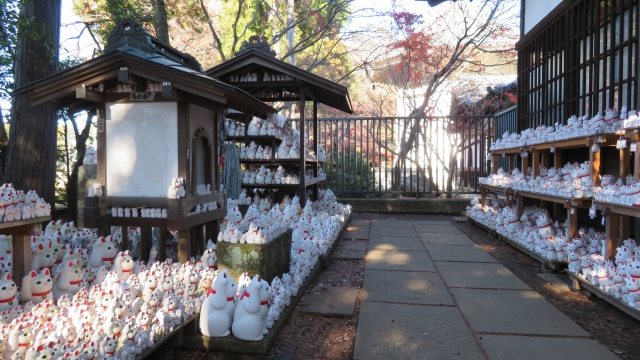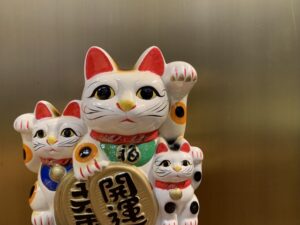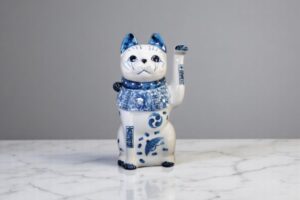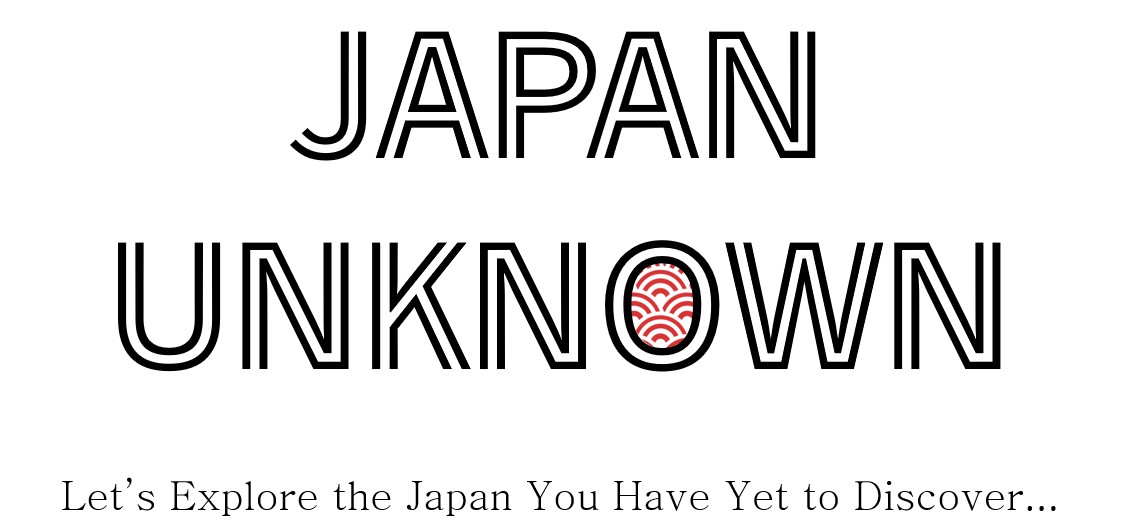A small cat sits quietly, raising one paw as if gently calling to you.
You’ll find this familiar figure in countless corners of Japan—by shop entrances, in homes, on windowsills—always watching over daily life with a quiet presence.
Though unassuming, the maneki neko, or “beckoning cat,” offers a curious warmth.
It comforts, reassures, and somehow feels like it belongs. As if it’s always been here. A silent guardian inviting happiness in.
A Legend Born in the Streets of Edo
The true origin of the maneki neko remains a mystery, wrapped in folklore passed down through generations. Among the most beloved stories is the one tied to Gotokuji, a Zen temple in Tokyo’s Setagaya ward.
As the tale goes, a samurai once took shelter beneath a tree near the temple. There, he saw a white cat raising its paw as if beckoning him closer. Intrigued, he followed—and just moments later, a sudden thunderstorm rolled in. Had he stayed where he was, he might not have survived.
Grateful, the samurai—later said to be the feudal lord of the Ii clan—became a patron of the temple. In honor of the cat that saved him, figures were made in its likeness: the first maneki neko.
Even today, Gotokuji’s grounds are filled with rows of white cats, red ears perked, quietly watching over the wishes left at their feet.

Gotokuji Temple, Where Countless Maneki Neko Beckon Good Fortune
Another origin story is whispered in the Imado district of Tokyo’s Asakusa.
According to the Buko Nenpyo, a historical chronicle from 1852, an elderly woman living in poverty was forced to part with her beloved cat.
That night, the cat appeared to her in a dream, telling her to shape its image into a doll—and that doing so would bring her fortune.
She did as told, crafting a figure in clay and firing it in the local style of Imado-yaki.
The cat figurines, plump with round faces and marked with a “marushime” (circle-seal) symbol on the chest, quickly became popular when sold near the torii gate of Asakusa Shrine. Known today as the “Imado Marushime Cat,” this version of the maneki neko is still cherished.

The Marushime Cat – Lovably Absent-Minded Expression Adds to Its Charm
Which story is true?
Perhaps we’ll never know. But each tale shares one truth: that people entrusted their hopes and prayers to a small cat. In doing so, they gave form to the intangible—a gesture so deeply woven into the Japanese way of seeing the world.
The Meaning in a Raised Paw
That single lifted paw—so simple, so gentle—carries meaning beyond its charm.
A cat raising its right paw is said to bring wealth and good fortune.
One raising its left welcomes people and relationships—customers, friends, connection.
For businesses, the left paw is preferred. At home, the right. Each gesture reflects the kind of blessing one seeks.
Some cats raise both paws, reaching upward in a double invitation. Some say it means inviting all forms of luck; others see it as “throwing up one’s hands”—a playful symbol of wanting it all. These variations carry not only different hopes, but also the quiet humor and artistry of the people who create them.

It is said that a cat raising its right paw brings in good fortune and wealth, while one raising its left paw invites people and good relationships.
Color and Meaning—A Spectrum of Wishes
When we think of the maneki neko, we often picture the classic: white body, red ears, golden bell, red collar.
That red is no accident—it was once thought to ward off illness and evil. White, sacred and pure. Together, they offered protection and peace.
But in modern times, the palette has expanded.
Each color carries a different prayer:
- White: good luck and blessings
- Black: protection from evil
- Red: health and safety
- Gold: wealth
- Blue: success in studies
- Pink: love
- Green: health and harmony at home
These colors reflect the many shapes a wish can take. Just as no two lives are the same, each maneki neko wears a color—and a story—of its own.
Beyond color, the materials and expressions of maneki neko vary with region and tradition.
In Seto, Aichi Prefecture, porcelain cats shine with a clean, refined beauty—a legacy of centuries-old Seto ware.
In Tokyo’s Imado, rough-textured clay cats with rounded forms and endearing, slightly silly faces echo the warmth of the old downtown neighborhoods.
In Fukuoka and Kyoto, wood-carved cats are lovingly shaped, then finished with lacquer or paint. Their grainy textures and subtle expressions bring the spirit of nature into the home.
Wherever they’re made, each cat reflects the soul of its place—its craft, its people, its quiet hopes.

Maneki Neko Made of Seto Ware (Seto-yaki)
Across Japan, skilled hands continue to shape these cats, one by one.
They spin clay on a wheel, mold each form, paint each detail, smooth each face. And in the final brushstroke, they offer their own unspoken wish:
That this cat may bring warmth to someone, somewhere.
That it might quietly sit by their side.
That it might make the invisible—hope, connection, care—just a little more real.
In the corner of a shelf, in the entranceway of a shop, in the quiet of a room—
the maneki neko watches, waiting.
It raises its paw not for itself, but for someone else’s happiness.
And perhaps, at this very moment, a tiny cat somewhere is gently calling luck into your life, too.




コメント